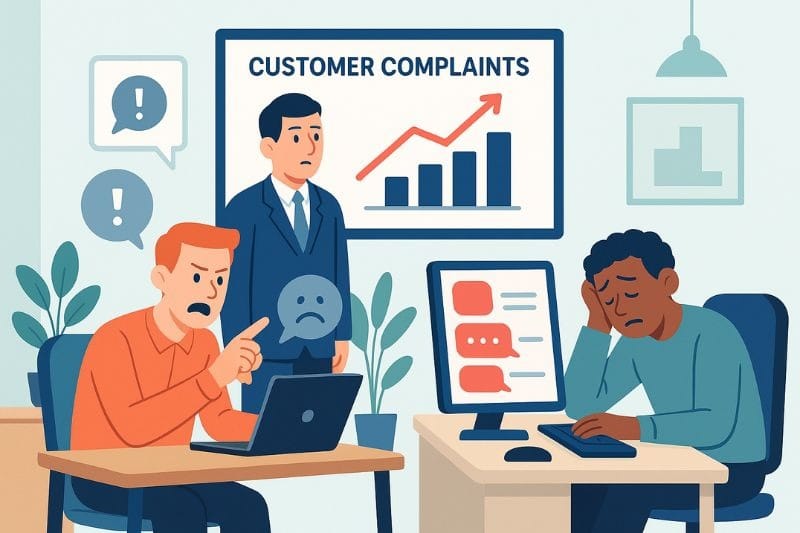How to measure employee engagement without surveys
Discover how to measure employee engagement without surveys by using existing business metrics like turnover and absenteeism. Improve engagement with BuddiesHR

It feels like it happened overnight…Your teams started losing their steam, productivity took a nose dive, and then resignations started. Before you could get back the results of the annual employee engagement survey, your top performers were gone, and your profits were down by 40%. It felt like you were asking passengers of a sinking ship whether they liked their breakfast buffet.
It wasn’t that the employee engagement research was useless - it was just way too late. You need valuable insights when they matter most. So you begin to search for what’s been in plain sight.
In this article, we discuss how to increase employee engagement without relying on surveys, but rather using employee engagement metrics that already exist in your business.
Quick Overview
Measuring employee engagement without surveys involves the use of key metrics that are already available in your business. These can include employee turnover, tenure length, key performance indicators, snap polls, customer satisfaction indexes, performance reviews, and exit interview feedback.
Table of Contents
- Metrics that point to high employee engagement
- Metrics that point to low employee engagement
- Conclusion
- Frequently Asked Questions
Metrics that point to high employee engagement

Your company’s employee engagement efforts show up all over your business, and by noticing the signs, you’ll quickly tell if you have engaged employees or not. The question is: What are the signs?
Certain behaviors leave behind measurable traces of information. Here’s where you can begin mining for information that shows you have effective employee engagement strategies.
1. Low resignations amongst high performers
Few things speak louder than who stays and who goes. Employee feedback has shown that a high level of mutualism - where a relationship is deemed to be mutually beneficial is a key reason behind low turnover. To put it another way, we humans like the idea of giving our all, as long as we receive the same commitment in return.
When your top performers hang around and keep doing well, it confirms that these employees feel valued.
2. Long tenure length
When a large percentage of your employees have +5 years of service, it’s a strong endorsement of high engagement levels, likely coming from a strong workplace culture. Longevity signals employee satisfaction, and loyalty to your company - exactly what employee engagement programs target.
⭐ Pro Tip: Acknowledging employees who stay with your company reinforces the value of loyalty in your culture. Use an app like Billy from BuddiesHR to promote work tenures and celebrate with work anniversary memes!
3. High eNPS scores
This score tells you how likely your employees are to recommend your company as a place to work. Promoters are the highly engaged employees who score >9, showing they have job satisfaction and are enthusiastic about your company.
Although technically a survey score, the eNPS differs from long-term surveys in that it is a pulse survey that can be sent monthly. It's quick, powerful, and highly effective for gauging employee sentiment.
4. Visible employee recognition

When evidence exists that employees are recognizing one another for displaying company values, tracking employee engagement is easy. In a nutshell, you want your employees to know when your company values are being shown by others, and feel comfortable praising and acknowledging one another.
How can you pick up on these trends on communication platforms? By integrating an app like Clappy Kudos. While your workers give a ‘kudos’ (a recognition high five), the app tracks engagement trends.
5. Active participation in performance reviews
When your team shows up to performance reviews prepared, actively listening, asking questions, and giving meaningful insights, you can be sure they are not just putting their best foot forward; they’re committed. Highly engaged workers show a 22% higher participation in company goals, according to Gallup research. [1] This translates directly into better business outcomes.
Get the most out of your performance reviews. In, What Is A Performance Review And How To Conduct Great Ones, we discuss how conducting great reviews can increase employee engagement.
6. High performance levels
Productivity can be a strong indicator of employee engagement levels. When targets, OKRs, or KPIs are regularly met, it is a signal that employee morale and drive are high. A Gallup report showed that engaged employees produce 14 - 18% more and are 23% more profitable than their disengaged counterparts. [1]
If you want to know whether your employee engagement programs are directly impacting performance levels, correlate these initiatives with spikes in productivity. For example, record whether the roll-out of a new recognition platform or paid time off program coincides with increased performance.
7. High customer satisfaction
Engaged employees achieve 10% greater customer satisfaction.[1] Customers often mirror employee sentiment. When there is drive, motivation, commitment and satisfaction, it not only reflects in business performance but also in customer ratings. When high customer satisfaction scores correlate with high eNPS scores, you can see firsthand how effective your engagement initiatives have been.
Metrics that point to low employee engagement

We’ve been discussing signs of high employee engagement, but now let’s flip the script. Fortunately, disengagement also leaves visible clues for you. By knowing what to look for, you can spot them early and do something about it before it becomes a systemic problem.
1. High staff turnover
When employees are running for the door in droves, it’s not only disruptive but also puts strain on business finances. Estimates through the years have put the cost of replacing a worker somewhere between $225,000-$300,000. [2] While high turnover is a sign of disengagement, the source of it can be less obvious.
Poor management, a disregard for employee well-being, immense pressure to perform, and senior management are just some of the reasons. Exit interviews are an excellent way of getting to the root cause (if employees are willing to be honest).
2. High absenteeism rates
Engagement data collected by the international research company, Gallup, shows that employee absenteeism rises in the face of disengagement. When people no longer feel connected to their work, the culture, and one another, they simply don’t want to be around that. You can also see this effect after major organizational changes, like mergers.
Need a simple, yet fast way to track absenteeism trends? Palmy Vacation provides the analytics you need while also speeding up leave approvals. You’ll see requests for time off in real-time, and where the absenteeism is concentrated. 👉 Try Palmy Vacation for leave tracking and analytics that help measure employee engagement.
3. Low regard for company goals and culture
Does this sound familiar? You’ve tried to roll out an employee recognition program, but have had little success. You feel like you’re constantly communicating goals but seeing little progress. You want to have meaningful conversations (1:1), but you get shallow, short responses in return.
If you’ve experienced anything similar, you’re likely frustrated by the lack of employee participation, and it could be pointing to employees clocking out mentally and emotionally.
4. High level of customer complaints

Here, it’s not just that the customer complaints are increasing, but it’s also what feedback you’re getting. Complaints about poor service, lack of knowledge, and long wait times in attending to queries mirror the points discussed above. When employees check out, so does their concern about the happiness of your customers. These two metrics together signal a pretty big problem with employee disengagement.
5. Negative interactions on communication platforms
Tone matters, and so does what is being discussed on communication platforms. For instance, if your Slack workspace is being filled with passive-aggressive comments, sarcasm, negativity about others, and frustrations, it could be a signal that employee engagement is suffering.
🔎 Learn how to set up keyword notifications in Slack. This is a quick and easy way to get notified when certain phrases or words are being used that you need to know about. For example: resignation.
6. Negative feedback during exit interviews
If you’re lucky, the exiting employee will be honest and open enough to tell you the real reason for their departure. This kind of feedback can be invaluable for discovering where the real source of employee disengagement lies. Increase the employee’s sense of safety and trust by outsourcing your exit interviews, and do them 2-3 weeks after the employee has left. By then, they’ve had time to think and will be more objective with their feedback.
7. Refusal to participate in team activities
On the surface, skipping the online trivia activity or team lunch may seem harmless. People get busy, some are shy, and others despise team building. However, when it’s pervasive and consistent, you could be dealing with disengagement.
The key is to notice whether participation has suddenly dropped or has never really been there. For instance, if there used to be great excitement about fun team activities, but now it's no longer there, something has caused this decline. Often, candid one–on-one meetings will get to the bottom of the problem.
Conclusion
In this article, we’ve covered fourteen ways to measure employee engagement without surveys. The data to prove engagement (or disengagement) is readily accessible in every business, if you know what to look for. By picking up on these tell-tale signs, you’ll be empowered to change employee experience in the short term, without waiting for the annual employee engagement survey.
Are you struggling with employee engagement? Try the BuddiesHR suite of engagement apps designed for Slack. They’re a simple and fun way to get your employees involved in your culture.
Frequently Asked Questions
1. How do I measure employee engagement?
Effective measurements of employee engagement include pulse surveys, an employee net promoter score (eNPS), peer-to-peer recognition and communications, annual engagement surveys, and performance metrics, to name a few. Other effective methods are absenteeism rates, attrition rates, and receiving qualitative feedback, like participation in company culture.
2. What are the 5 Cs of employee engagement?
There is no global definition of the 5 Cs of employee engagement; however, two common versions are often referenced, i.e., Care, connect, contribute, congratulate, and coach, or communication, connection, culture, contribution, and career development.
3. How can I measure the satisfaction of my employees without a survey?
Firstly, define what employee satisfaction means. Once you understand this, you will be able to measure it. Common metrics for evaluating satisfaction in the workplace are: Absenteeism, employee tenure length, one-on-one feedback, ‘culture health checks’, and tracking trends on platforms such as Slack.
References




